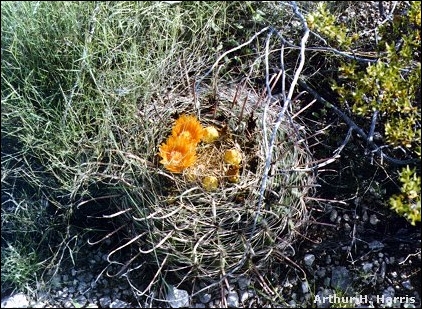

When many people think of a desert, cacti are the first things to come to mind! Certainly we have many other types of plants in our Chihuahuan Desert, but cacti have a wonderful collage of adaptations that help them survive in difficult desert climates.
Consider our barrel cactus with roots that form a kind of mesh net, reaching out across the desert. This helps them soak up rain as soon as it falls. Accordion-like folds on the cactus help it expand to store as much water as possible. The spines on the Fishhook Barrel Cactus not only protect it from the sun and thirsty animals, they were once used by Native Americans as fish hooks.
Some people expect the Barrel Cactus to have a large cavity inside,
full of water. The liquid is really stored in the tissues of the cactus, though, so
decapitating one wouldn't provide a ready supply of water. These cacti were used
for cactus candy, but the cacti were being harvested faster than they could grow;
over-exploited to the point of rarity. With loss of this resource, the cactus
candy-making industry disappeared.

Listen to the Audio (mp3 format) as recorded by KTEP, Public Radio for the Southwest.
Contributor: Elaine Hampton, Assistant Professor, Department of Teacher Education, University of Texas at El Paso.
Desert Diary is a joint production of the Centennial Museum and KTEP Public Radio at the University of Texas at El Paso.

A Barrel Cactus in bloom. Photograph by A. H. Harris.
Technical
Correll, D. S., and M. C. Johnson. 1970. Manual of the Vascular Plants of Texas. Texas Research Foundation, Renner, TX, 1881 pp.
Popular
Phillips, S. J., and P. W. Comus. 2000. A Natural History of the Sonoran Desert. Arizona-Sonora Desert Museum Press, Tucson, 628 pp.